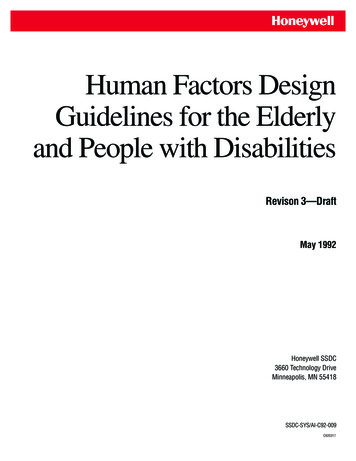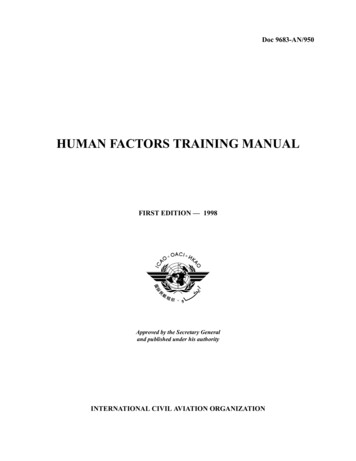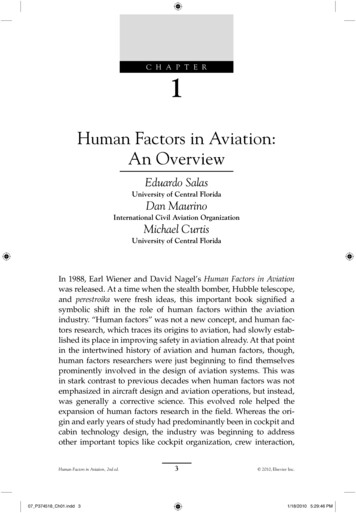
Transcription
International Journal of Science and Engineering Research (IJ0SER),Vol 3 Issue 2 February -20153221 5687, (P) 3221 568XA Study On The Factors Influencing EffectiveCommunication In The Construction Industry¹ S.Vaijeyanthi, ² D.Ambika¹ Final Year M. E. Construction Engineering Management,² Assistant Professor -Department Of Civil Engineering, ,Kongu Engineering College, Perundurai, Tamilnadu, IndiaAbstract-The construction industry of India is an important indicator of the development as it creates investment opportunities across variousrelated sectors. Most common reason for construction disputes is breach in communication and expectations. Concerted effort is necessary tofacilitate communications between the team members. Good communication within an organization and between organizations contributing tothe construction project can improve the productivity. Increasing the productivity eventually leads to the minimisation of cost.Communications’ effectiveness is a function of matching communication patterns to the nature of the project team task. Communicationproblems can be minimized only when their causes are identified. All requests for information, change order requests, and directives to andfrom the Client should be introduced in writing and addressed through proper channels to ensure issues are responded to by the right partywithout delay. Poor co-ordination and communication of design information lead to design problems that cause design errors. The objective ofthis study was to identify the major causes of communication problems occurring in construction. This study was carried out based onliterature review and a questionnaire survey. The factors influencing communication has been identified and this has been used for preparingquestionnaire. The data for this study will be gathering through a detailed questionnaire survey. The questionnaire is prepared for threecategories of people namely workers, site engineers and contractors separately. This categorization was done because it was identified thatmajor communication is among these three categories of people based on the literature review and expert opinion. The questionnaire form isforwarded to various construction industries through email and in personal.INTRODUCTION1.1GENERALhigh differences in interests among the participants ofconstruction projects.Communication can be viewed as a metaphorical „pipeline‟along which information is transferred from one person to another.Communication within project-based environments presentsspecial challenges. This is especially true within the constructionindustry, where interaction tends to be characterised by unfamiliargroups of people coming together for short periods beforedisbanding to work on other endeavours.The construction industry operates primarily as a system ofsub-contracting and purpose built alliances to bring a program tofruition and manage it thereafter. There is a wide spread ofstakeholders involved in conceiving a building project throughtypical stages such as design, finance, build, manage, upgrade and,ultimately, replacement. There is therefore a major need forcommunications to be systematic, understood by all stakeholdersand intelligently applied.Many of the problems that develop in constructionprojects are a result of both the temporary and inter-disciplinarynature of project teams. This complicates an already problematiccommunication environment in which technical language, anadversarial culture and noise/distraction all combine to preventstraightforward information flow from one party to another.Successful implementation of a construction project usuallyrequires huge funds.In a construction project, it is natural that different teammembers strive to achieve their own objectives. There is a constantstruggle between “mutual interests” and “individual interests” ofthe different parties. Based on these two types of interests, interorganizational relationships could be cooperative, competitive,regulating or conflictive. The traditional owner–contractorrelationship is mainly competitive in nature which leads to a lowdegree of objective alignment.Construction conflicts affect the interests of many stakeholdersin connection with big investments; they reduce profits and aretherefore very expensive and unprofitable. However, thestakeholders become increasingly dissatisfied with the legalmethods of construction conflict resolution. As a result, theexisting confrontational culture often determines a reduction inlabour efficiency and an increase in production costs. In theconstruction industry, conflicts sometimes seem inevitable due toIn the context of construction conflicts, it should be notedthat the parties to a construction contract agreement are bound bythe contract. Their activities and relationships are regulated by thecontract and law.Vaijeyanthi. . (IJ0SER) February - 2015
International Journal of Science and Engineering Research (IJ0SER),Vol 3 Issue 2 February -20153221 5687, (P) 3221 568Xin safety. Communication will be more effective when participantstake a proactive approach ability to take initiatives by exhibitinggoal-directed behaviour. Despite this, a proactive approach doesnot always guarantee effective communication.Indeed, as a communication chain becomes longer, it ismore open to „noise‟, i.e., forgetfulness, laziness and prejudices.Although often not intentional, this „noise‟ has the potential to leadto differences between the expectations of clients, designers andconstructors. These differences have the potential to have negativeimpacts on the construction process by affecting team members‟attitudes, perceptions and objectives. It is also important to notethat, while team members can have good intentions regardingcommunication, the methods and channels used can sometimeshinder these efforts.Fig.1.1 Negotiation model for contract between thecontractor and the client1.2OPEN AND EFFECTIVE COMMUNICATIONBy ensuring a culture of effective communication at theclient, designer and constructor level, an environment of open andflexible communication for all parties is created. This enhancedcommunication regime is not only beneficial to building therelationship between the management team, but also to the projectas a whole. A lack of effective communication, while it hinders therelationships of the management team, also has for furtherimplications. It is important to create an environment for effectivecommunication and the risk of insurance claims is reduced whengood communication is affected.A lack of effective communication between the designerand constructor leads to time delays. A project team needs tounderstand the value of effective communication in order to excelVaijeyanthi. . (IJ0SER) February - 2015For communication to be truly effective, mutualunderstanding and collaboration between the sender and receivermust exist. A proactive approach employing a two-waysymmetrical model of communication is suggested as a means tofacilitate congruency between the project team. It also allows afree flow of information back and forth betweenparties, thereby assisting with the development of positiverelationships. For the client, designer and constructor to achievethis, all three parties must agree on chosen means ofcommunication. To enhance effective two-way communicationflow between the client, designer and constructor, efficientcommunication channels must be employed. These channelsshould be as short as possible in order to achieve noiseminimisation. This could be facilitated through face-to-facediscussions, workshops, emails or tele/video conferencing.Although email is regarded as a useful communication technology,the ability to convey the meaning via body language, cadence andtone are lost, with the potential for content to be misconstrued. Forthese reasons, face-to-face communication is better.Promoting shorter distances between communicators willlead to more efficient feedback and enhanced spontaneity. Apositive correlation exists between groups working in a face-toface situation and the achievement of greater team orientation.Thus face-to-face communication allows the development ofproject-specific goals and objectives.Construction projects are, for the most part, constructed insitu. Even with the increased use of off-site fabrication and thewider use of pre-fabricated components, the final product isnormally assembled and completed in the required site location.This necessitates the employment of an itinerant workforce, whichcan move from one project location to the next. This transience oflocation and the temporal nature of project teams poses manyproblems for workers such as longer working days, more expensein travelling to work and managing work/life balance issues, sincetheir families may not be as mobile.1.3IMPORTANCE OF EFFECTIVE COMMUNICATION
International Journal of Science and Engineering Research (IJ0SER),Vol 3 Issue 2 February -20153221 5687, (P) 3221 568XThe importance of effective communication to individuals,teams and organisations cannot be overstated. Virtually every texton how to manage people will contain important principles of howto communicate effectively with the workforce. Similarly, themanagement of organisational processes also demands that robustand effective communication channels are developed which enabletheir various components to be conjoined appropriately. Theimportance of communication to organisations is succinctlysummarised by Armstrong (2001: 807): Achieving coordinated results – organisations function bymeans of the collective actions of people, but independent actionslead to outcomes incongruent with organisational tivecommunications. Managing change – most organisations are subject tocontinuous change. This, in turn, affects their employees.Acceptance of and willingness to embrace change is likely only ifthe reasons for this change are well communicated. Motivating employees – the degree to which an individualis motivated to work effectively for their organisation is dependentupon the responsibility they have and the scope for achievementafforded by their role. Understanding the needs of the workforce – fororganisations to be able to respond effectively to the needs of theiremployees, it is vital that they develop an efficient channel ofcommunication. This two-way channel must allow for feedbackfrom the workforce on organisational policy in a way thatencourages an open and honest dialogue betweenemployees at all levels and the top-level managers of theorganisation.PAST RESEARCH WORK COMMUNICATION IN CONSTRUCTIONPROJECThorizontal, diagonal and lateral, resulting in successful feedback.Thus, project managers who allow the team to take responsibilityfor their work will attain more from team members andcommunication will be more effective. The results indicated apeople-orientated approach towards the management of a project.FACTORS IDENTIFICATION4.1 IDENTIFYING FACTORS INFLUENCING EFFECTIVECOMMUNICATIONFrom the literature survey and the experts opinion,various factors influencing communication are identified. They are Improper interactionMistakes in agreementProblems in communication other than drawingsControversies with other partiesMisinterpretation of drawingsFlow of informationMistakes in the drawingsType and size of the projectNot assigning the responsibilities properlyDelay in making decisionThese are common factors and for designing thequestionnaire, factors relating to the three categories wereseparated. There are many methods in distributing thequestionnaire form. The prepared questionnaire forms aredistributed by post, email and in person. In addition to this,comments, suggestions are received from the respondent throughthe discussions with them.Mitkus S., et.al (2014) demonstrates that product ofcommunication between the parties-contract agreement(differently interpreted by the parties). It means that the mostfrequent cause of construction conflicts is unsuccessfulcommunication between the parties to a construction contractagreement. Due attention to the drawing up of constructioncontract agreements would create strong immunity againstpandemic conflicts and disputes. Other causes of conflicts in theconstruction industry identified in this article include unfairbehaviour of construction participants and psychological defencemechanisms. Participants of the project should think that everyperson involved in the project are responsible for propercommunication. If new techniques are adopted in a project, and if theworkers are not properly trained, there will be a lot ofcommunication problems.Zulch B. (2014) concludes that project team members need tocollaborate, share, and integrate information and knowledge torealise project objectives. A project manager does notcommunicate with language only, but also with character, whichincludes attitude, behaviour and personality. Allowing teammembers to take responsibility for their work and sharing thevision with team members will enhance the formal flow ofinformation in all directions, namely upward, downward, If the participants of the project don‟t have trust on eachother, they will not be willing to communicate properly.Vaijeyanthi. . (IJ0SER) February - 2015 Since different companies may work in a single project,misunderstandings between them will greatly influence the successof the project. If the participants are of different mindset and are ofopposing nature, problems will arise. The flow of information should be proper without anyinterruptions. If the project participants don‟t interact properly witheach other, ideas or information cannot be conveyed or understoodproperly.Construction is a process with the following key players: client,contractor, subcontractor, designer, construction technical
International Journal of Science and Engineering Research (IJ0SER),Vol 3 Issue 2 February -20153221 5687, (P) 3221 568Xsupervisor, workers. However, the analysis is focused on conflictsbetween the parties directly participating in the constructionprocess, i.e., among the workers, supervisors and TANTSCommunication between the client and the consultants is acontinuous process from the inception of the project till the finalcompletion. The client is the initiator and financer of the projectand the project must be executed to suit his needs andrequirements. The first communication in this stage is the client‟sstatement of requirements. It includes information about the size,nature, availability of funds, functions and time limitations of theproject. The client‟s communication should be accurate in this caseas many stakeholders participate in development of hisrequirement functions. The architect or quantity surveyor aftercarrying out feasibility studies with other consultants who havebeen appointed to establish that the project is feasible,functionally, technically and financially, prepares a general outlineof client requirements and communicates it to the rest of themembers of the design team for collective action. Thedevelopment of the client‟s brief is a collective effort of all theconsultants who in the course of granting approval for such workcommunicate any alterations and modifications they want effectedin the project to the consultants. This procedure continues until thedesign of the project is completed and the consultants jointlypresent their design report to the client to confirm that it is a cleartranslation of his brief. The design report must be detailed toinclude all relevant information required and presented in amanner to be understood by the client (Ayeni, 1986). Theinterviewees of this study found that in Indian context, this is acrucial problem. Most of the times, there is a communication gapin understanding the client‟s needs by the consultants and on theother hand, in understanding the planning and technical detailsreported by the consultants to the clients.4.3 COMMUNICATION BETWEEN CONSULTANTSThis involves effective exchange of ideas and informationamong the professionals within the design team to advice the clienton smooth running of the project. During this phase, thedocumentation for tendering and contracting the physicalconstruction or for procuring equipment is prepared. There is alsoa need for architectural, structural and service drawings to berequired by the quantity surveyors. The specifications must beclear, definite and concise so that when read with the drawings,they set out the quality of materials and the workmanship orstandard required in the project to enable the quantity surveyor toprepare his bill of quantities. During the progress of the work, allof architect or engineers‟ instructions intending to alter the originalscheme of work are sent up to the quantity surveyor and must bedetailed enough to enable him establish the cost implication of theproject and give professional advice. The changes in the designsalso need an approval of the client and the important stakeholdersof the project. Most of the interviewees pointed out that, a properflow of communication from the client to design team, from designVaijeyanthi. . (IJ0SER) February - 2015team to client and then after evaluation, from consultants tocontractors should be followed. If any step of this flow is ignored,it generates a series of conflicts and misunderstandings. Regulardesign and specification review meeting is one of the importantfeatures of this stage of the project. Arranging the documents ofthe construction contract, negotiating with the qualified designprofessionals, providing the qualified design professionals with theneeded information, updating and reviewing design documents,negotiating contract price with qualified contractor, interpretingand clarifying ambiguities in the contract documents etc. areimportant communication activities in this stage.4.4 COMMUNICATION BETWEEN CONSULTANTS ANDCONTRACTORAll emphasis in this stage has been laid on consultants‟planning, carrying out studies into areas that might affect thesuccess of the proposed project and exchanging informationbetween the planning team and client. In this stage, thecommunication network is extended to a very important memberof the construction industry, the contractor, who translates allefforts of the consultants into reality which should correspond withthe client‟s requirement. The idea of tender for a project is firstcommunicated to contractors through public advertisements orinvitation letters depending on the tender procedures adopted. Thequantity surveyor examines the bill of quantities andcommunicates his findings and recommended actions to the clientthrough a tender report for the purpose of selecting the mostsuitable contractor. The same procedure is used to select specialistsub-contractors. Consultants regularly communicate and follow upwith the contractors to ensure that the contract provisions areapplied. There is also an interim evaluation wherein exchange ofinformation between the contractor, quantity surveyor and thedesign team happens. The interviews were of the opinion that thecommunication between the consultants and the contractor is acrucial stage. They pointed out that the consultants have to provideclear information to contractor without any ambiguity whichfacilitates the smooth functioning of the construction project. Inlarge-scale construction projects in India, different consultantswork together. Their location might be scattered. At times some ofthe members of design team are of foreign countries and in suchcases communications between them and the Indian contractorfirm plays an important role in proper execution of the project. Ifthis is not done properly, project execution doesn‟t happen asplanned. The effects of communication problems in this stage asper the interviewees were wrong constructions, delays, costoverruns etc. which might occur due to improper communicationbetween the consultants and the contractors.4.5 COMMUNICATION AT SITEThe construction site is a place where the entire effortsmade by the design team in visualizing the client‟s requirementswill be put into practice and hence communication on site involvesall parties responsible for the project. The interviewees selected for
International Journal of Science and Engineering Research (IJ0SER),Vol 3 Issue 2 February -20153221 5687, (P) 3221 568Xthis study were of the opinion that it is the most importantcommunication stage of all stages. They pointed out differentprocesses where role of efficiency in communication is veryimportant at this stage. As per them, apart from the formalcommunication between the contractor and the consultants in formof drawing, specifications, schedules and the bill of quantitieswhich shows the extent of the work to be done, the contractor isalso in close contact with the consultants during site meetings.Generally, site meetings are the regular meetings held on theconstruction site to discuss the progress of the project till date andthe difficulties and delays which arise during various stages of theproject. This gives the contractor and his principal sub-contractorsa good opportunity to sort out their issues with the design team.The site meetings are expected to establish a good link between allthe parties involved. The biggest communication challenge in onsite communication as per the interviewees is the informationabout variations in designs and other specifications. If thesechanges are not communicated formally and in written form, it canspoil the project construction activities and disputes might ariseout of this. Another important form of onsite communication isweekly reports and monthly reports. They are a valuable documentfor the consultants as these keep them informed about the dailyactivities on site. It also serves as a reference when dispute arisesat a later date. Communication within the contractor‟s organizationincludes communication between work area, control points andstorage areas. Communication between the store team and theexecution team is most common. It is a link between manpowerand materials. This aspect of communication is really veryimportant as the work force is an essential part of the industry.This is because unless labour receives regular flow of materialsand also is informed of what to do with them, work will definitelynot happen no matter how good the management is. Anotherimportant communication in this stage happens between controlpoints and work area where managers and supervisors are in closecontact with the work men via verbal or written information. Theproject manager prepares communication plan at the beginning ofthe project and coordinates with various participants tosuccessfully implement the project.The interviewees said that the communication with labourers isagain a very crucial thing on construction sites. Especially, in acountry like India, where labourers from different states, differentcommunities, and speaking different regional languages cometogether, communicating with them becomes a critical issue. Theconstruction managers, site supervisors and the project managersshould essentially be able to communicate efficiently with themunderstanding their problems for the smooth functioning of the siteoperations.Almost all interviewees were of the opinion that on-sitecommunication failures generate a series of problems in projectexecution. Various problems occur in information managementwhich includes the lack of maintenance of site records defects inmany constructed works etc. Poor co-ordination andcommunication of design information lead to design problems thatcause design error.4.6 ALLIANCE CONTRACTINGVaijeyanthi. . (IJ0SER) February - 2015An alliance contract offers clients and contractors apractical solution to overcome the recurring problems encounteredin the traditional design-and-construct-style contract. Suchcontracts take the form of agreements binding the parties togetherwith respect to targets, risk and reward mechanisms. The entirealliance entity is therefore at risk of failure should something goawry, a feature which essentially alters the group dynamics,motivation and cohesiveness between the alliance members vis-àvis those of a traditional contracts. In this way, alliance contractinghas the ability to recognise conflict and ensure timely andcollaborative resolution of issues. Traditional contracts placeresponsibility and risk on the constructor, which can potentiallylead to conflict, contractual disputes and expensive claims. Analliance contract, however, can potentially distribute riskthroughout the alliance team. A limitation to this contractingmethod is a lack of multidisciplinary skills on the part of the client,designer and constructor, which may limit the scope ofcommunication between them. However, if mutual interaction,effective communication and the sharing of resources is promoted,the complementary expertise of team members can overcome thesebarriers. Novice or unprepared team members may also pose apossible limitation to this style of contract since they might findthe concept too challenging, or else may not realise the value ofhigh-level collaboration.RESULTS AND DISCUSSION5.1 DATA ANALYSISTotally for five companies the questionnaires were given.The questionnaires were given for eight workers out of which fiveresponded. Hence for workers the response rate is 62.5%. Thequestionnaires were given for six supervisors out of which threeresponded. Hence for supervisors the response rate is 50%. Thequestionnaires were given for five contractors out of which tworesponded. Hence for contractors the response rate is 40%. Theresults obtained were given in bar charts for the three categoriesseparately.5.2 WORKER:type ofcommunicationindirectdirect0246
International Journal of Science and Engineering Research (IJ0SER),Vol 3 Issue 2 February -20153221 5687, (P) 3221 568Xtrainingtrainingeasy accessibilityNOExperienceYES01234easy srarelysuggestionsinteraction with ownerofteninteraction with ofteninteraction with ownerinteraction with 0024veryoften5comfort zonevery lowtype & size of projectcomfort zonevery lowtype & size of lowlanguage problemlowmedium01234highmediumlanguage problemhigh01234Fig. 5.1 Responses from workersINFERENCE:The average percentage was taken for analysis of workers.It is seen that direct communication is the best way ofcommunication. It is also seen that experience and training hasgreater impact on communication and the language problem variesaccording to the site. Interaction with owner is very rare.Fig. 5.2 Responses from supervisorsINFERENCE:The average percentage was taken for analysis ofsupervisors. It is seen that direct communication is the best way ofcommunication. It is also seen that experience and training hasgreater impact on communication and the language problem variesaccording to the site. They interact with owner rarely and with theworker often.5.3 CONTRACTOR:5.2 SUPERVISOR:type ofcommunicationindirectdirecttype ofcommunicationindirectdirect01Vaijeyanthi. . (IJ0SER) February - 201523400.511.5
International Journal of Science and Engineering Research (IJ0SER),Vol 3 Issue 2 February -20153221 5687, (P) 3221 568Xflow of lysuggestionsofteninteraction with interaction with worker024veryofteneffective communication. For the first phase, there are only fewresponses. Hence analysis is done using excel sheet. From thepeople responded, it has been identified that direct communicationis more effective than indirect communication. Also there arecontroversies with the clients and mistakes in agreement betweenowner and contractor which are not considered significant.For the second phase, analysis will be done using SPSSsoftware. SPSS is an analytical software, used to perform dataentry and analysis and to select the specified factors. Based on theresponses and analysis done, suggestion and recommendation willbe given to enhance the construction industry.REFERENCES1. Alaghbari W., Kadir M.R.A., Salim A., and Ernawati. (2007) „The significantfactors causing delay of building construction projects in Malaysia‟, Engineering,Construction and Architectural Management ,Vol. 14 No. 2, pp. 192-206.2. Aulich T. (2013) „The Role of Effective Communication in the ConstructionIndustry: a Guide for Education and Health Clients‟, Australian Journal ofConstruction Economics and Building, 13(4), pp 92-101.3. Brauers W.K.M., Zavadskas E.K., Kildiene S., Kaklauskas A., (2012)„Multiple criteria decision support system for assessment of projects managers inconstruction‟, International Journal of Information Technology & Decision Making,11 (2).controversies with very lowmistakes in agreementlowtype & size of projectmediumlanguage problemhigh0 0.5 1 1.5 2 2.5Fig. 5.3 Responses from contractorsINFERENCE:It is observed that controversies with client is high andmistakes do occur in the agreement. It is also seen that experienceand training has greater impact on communication and thelanguage problem is low. Type and size of the project influencescommunication greatly.CONCLUSIONIn the construction industry, the impact of communicationin productivity and budget is not considered seriously. Hence thisstudy will help in identifying the impact of communication. Thiswill help in inducing the participants of the construction project toconsider communication problems and also to obtain solution forit.Based on the literature review and opinion of the experts,some factors like misinterpretation of drawings, controversies withthe other parties, etc., have been identified as that influencingVaijeyanthi. . (IJ0SER) February - 20154. Chen L. and Mohamed S. (2000) „Impact of Organisational Cultural Factors onKnowledge Management in Construction‟.5. Ganesh Prabhu P. and Ambika D. (2013) „Study on Behaviour of Workers inConstruction Industry to Improve Production eff
A lack of effective communication, while it hinders the relationships of the management team, also has for further implications. It is important to create an environment for effective communication and the risk of insurance claims is reduced when good communication is affected. A lack of effective communication between the designer











